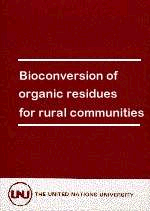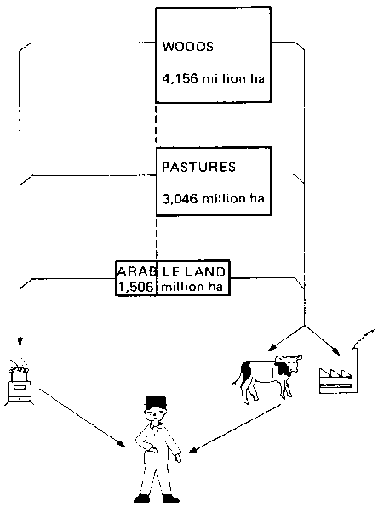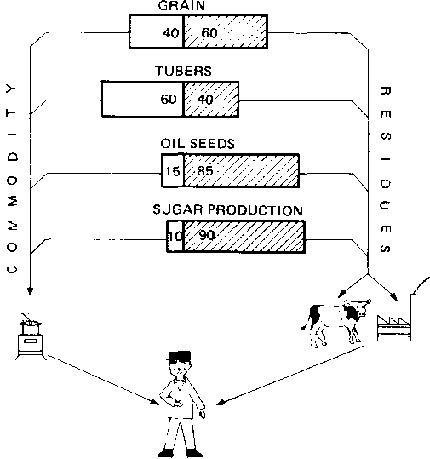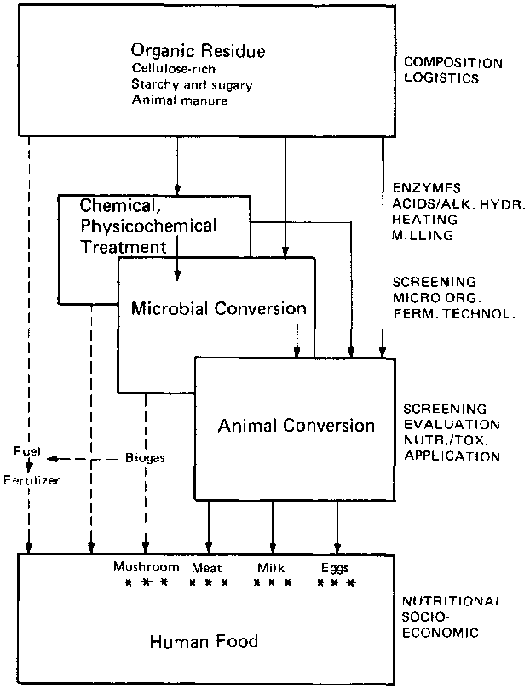
Bioconversion of Organic Residues for Rural Communities (UNU, 1979, 178 p.)
Perspectives on bioconversion of organic residues for rural communities[edit | edit source]
P. van der Wal
Institute for Animal Nutrition Research (ILOB), Wageningen, Netherlands
Introduction[edit | edit source]
The shortage of food in the world recently prompted the Director General of FAO, Edouard Saouma, to reiterate the special need for food in densely populated rural areas of developing countries (1). We need new food sources, and we should not restrict ourselves to increasing supplies of existing ones to meet this demand (2). In our attempts to develop these potentials we should, however, avoid theoretical overkills (3).
In this paper, I shall try to take these points into account while studying the question of whether new sources can be tapped to a significant extent, and whether these new rural sources can provide food that is affordable, whole some, and acceptable organoleptically. In view of the latter point, I would like to emphasize that, especially in rural areas, consumers are extremely critical. This is by no means limited to developing countries only. In the Netherlands, too, children are taught, "What a farmer is not familiar with, he does not eat."
Sources of available nutrients[edit | edit source]
An inventory of nutrient sources is rather illuminating (see Figure 1). There are approximately 9,000 million ha of land in the world. Close to 50 per cent of this area consists of forests and shrub lands. Another 35 per cent is pasture and grassland, and 15 per cent is arable land. Of the produce grown on arable land, by far the major part is discarded as residue. This means that approximately 95 per cent of the land areas mentioned in Figure 1 could provide a source of nutrients yet untapped in the sense that their agricultural residues are not being utilized directly for human consumption.
Figure. 1. Land Production of Potential Nutrients
Food science and technology at present concentrate mainly on the 5 per cent of the annual production of potential nutrients that can be used after relatively simple forms of processing, such as cooking or baking. The 95 per cent residue needs considerable processing, be it physical, chemical, or via some form of bioconversion before it can be turned into suitable feed or food. This paper will concentrate on the products that we refer to as organic residues. They are what is left after agricultural production, sometimes left behind on the land (straw), on the farm (manure), or in agro-industries. They are relatively easily available for conversion into food.
Figure 2 shows some of the most important agricultural crops. There is a line along which we can divide these products. On the left side we find the percentage considered to be the main food component of the crops. They can be used without much processing by the human consumer (grain, oil, starch, vegetable protein). On the right side are the residues that comprise approximately two-thirds of the total production.
Two routes are available to convert these residues into useful products, as indicated in Figure 2: through feeding to animals, or by some industrial process.
Because these residues form the major part of agricultural production, their conversion into food via efficient and safe systems deserves far more attention than we have paid it so far.
Tremendous efforts are required to make such new systems operational. Therefore, we should concentrate on a limited number of the most promising ones and approach them in a multi-disciplinary fashion.
Those of us involved in developing new conversion systems will agree that the creation of acceptable food from novel sources usually requires animal conversion as a last step. Microbial conversion alone produces, in most cases, biomass, e.g., single-cell protein that is not accepted as a food by most consumers.
The most suitable materials for bioconversion[edit | edit source]
To identify the most suitable areas in which bioconversion of residues may be important and therefore worthwhile, the residues are divided into three categories, each susceptible to a common method of bioconversion. Cellulose-rich substrates form a total of more than 1,800 million tons annually of renewable resources (Table 1). They are to a great extent found in Asia, and it is therefore not surprising that they consist primarily of rice straw. The present use is often none; in some areas it is used for fuel. Straw could form an extensive base for reeding ruminants. There is no doubt that bioconversion would greatly improve the use of these materials, particularly in rural areas. To what extent in vitro SCP (single-cell protein) production can play a major role here depends greatly on local circumstances and on the results of research efforts in this field.
TABLE 1. Straw Production, 1974 (in millions of tons)
| Crop | World | Africa | South America | Asia |
| Paddy rice | 323 | 8 | 10 | 294 |
| Wheat | 360 | 8 | 10 | 90 |
| Maize | 586 | 54 | 58 | 100 |
| Other straws | 441 | 41 | 18 | 123 |
| Total straws | 1,710 | 111 | 96 | 607 |
| Sugar-cane | 116 | 9 | 28 | 46 |
| Total | 1,826 | 120 | 124 | 653 |
The second major residue category consists of starchy and sugary wastes (Table 2). Because their carbohydrates are more easily accessible, they require a somewhat less difficult form of SCP bioconversion. As shown in Table 2, cassava and sugar beets provide the greatest amount of residue. High productivity in relatively poor soil has made cassava a popular staple food, especially in countries most in need of food.
TABLE 2. Starchy, Sugary Residues (in millions of tons)
| Crop | World | Africa | Latin America | Asia |
| Cassava | 106 | 42 | 33 | 30 |
| Sugar beets | 482 | 4 | 5 | 39 |
| Bananas | 8 | 1 | 4 | 2 |
| Citrus fruits | 12 | 1 | 3 | 3 |
| Coffee | 5 | 2 | 3 | - |
| Total | 613 | 50 | 48 | 74 |
A third category of residue is manure, a by-product of all animal production systems. It is calculated that approximately 1,900 million tons of manure are produced per year.
Characteristics of residues[edit | edit source]
Residues are not used as foods because they are inedible without some form of bioconversion. Table 3 shows that the chemical composition of most residues is not well balanced. Straw contains 48 per cent crude fibre and 3 per cent crude protein.
TABLE 3. Chemical Composition (% dry matter) of Various Residues
|
Grain* straw |
Leaf* (grass) |
Citrus** pulp |
Manure*** (poultry) | |
| Organic matter | 95 | 91 | 93 | 77 |
| Ash | 5 | 9 | 7 | 23 |
| Crude protein | 3 | 17 | 7 | 32 |
| Crude fibre | 48 | 27 | 14 | - |
| Nitrogen-free-extract | 43 | 44 | 69 | 27 |
* O. Kellner and M. Becker, Grundüge der Futterungslehre (1959).
** CVB Cattle Feed Table.
*** F. de Boer and A. Steg (Hoorn), report, "Megista mestdag," part II.
It is hardly a good product for human consumption. Grass has a better composition, but if it were to be used for monogastric consumers like man, there would still be severe problems because of the relatively high crude fibre content. Poor digestibility is another reason for rejecting unprocessed residues.
Table 4 gives the digestibility coefficients of some residues for ruminants. The organic matter of straw is only 38 per cent digestible even for ruminants. For monogastric organisms like man, poultry, and pigs, the coefficients are even lower. Grass is more digestible but less suitable for monogastrics. Digestibility of citrus and animal wastes is reasonable, but not particularly good.
TABLE 4. Digestibility Coefficients in Ruminants
|
Grain* straw |
Leaf* (grass) |
Citrus** pulp |
Manure*** (poultry) | |
| Organic matter | 38 | 72 | - | 72 |
| Crude protein | 12 | 75 | 42 | 78 |
| Crude fibre | 40 | 65 | 80 | |
| Nitrogen-free | 38 | 77 | 95 | 69 |
* O. Kellner and M. Becker, Grundzüge der Futterungslehre (1959).
** CVB Cattle Feed Table.
*** F. de Boer and A. Steg (Hoorn), report, "Megista mestdag," part II.
A number of other reasons may make a residue undesirable. Logistic aspects and low drymatter content may be expensive to overcome. Seasonal variability often makes it difficult to manage the material by advanced technology. Chemical and microbial contamination and organoleptic or psychological unacceptability may preclude the use of some residues as food. The above characteristics all present problems that must be overcome if a residue is to be converted to food.
Bioconversion systems[edit | edit source]
Figure 3 shows the pathways for the bioconversion of residues into food. In the upper box, cellulose-rich, starchy and sugary residues, and animal manure are represented. The lower box shows the goal of bioconversion systems: food for man. In most cases this will be in the form of meat, milk, or eggs.
It is frequently said that there seems to be a certain competition for food between animals and man. One easily overlooks that this is the exception rather than the rule. Most animals are kept for the purpose of producing food for man. They are mainly converters (biological ones) of products inedible by man. As such, they do not compete significantly for human food supplies.
We have many options for making food from wastes. The ones by-passing the animals are represented by the dotted lines in Figure 3. Direct use as food is non-existent, otherwise the product would not be a waste. Chemical and physical treatments of waste seldom create food. Microbial conversion, either direct or after treatment, permits mushrooms to grow and favours the production of fermented oilseed cakes. Unfortunately, this method is not yet used for the conversion of millions of tons of residues to any significant degree.
The solid lines on the right side of the figure represent bioconversion systems making use of animals. Grass, straw, and quite an amount of poor-quality roughage follow the direct route to food. Animal feeds may also be wastes that are treated via chemical or physical means and/or by microbial conversion, which the animal also converts to food. The potential and efficiency of bioconversion should be exploited to a much greater degree. In general, the right side of Figure 3 shows the most realistic potential for bioconversion of the bulk of residues into food.
Figure. 3. Bioconversion of Residues into Food
Physical and chemical treatments[edit | edit source]
The alkali treatment of cellulose-rich materials like straw (1,800 million tons in rural areas) deserves special attention (Table 5). Digestibility for ruminants improves from 45 to 68 per cent when straw is treated. What does that imply? in the major rural areas of India, untreated rice straw provides hardly enough nutrients to maintain the live weight of cattle; in other words, it barely covers the animals' maintenance requirements Assuming that 90 per cent of the feed is used for maintenance, 10 per cent is available for increasing weight, for producing offspring, and for milk production. If digestibility were increased by 50 per cent, it would provide, as in the Table 5 example, a fivefold increase in nutrients available for meat and milk production.
TABLE 5. Effect of Treatment on Straw Digestion in Sheep
| Treatment | Organic matter | Digestibility (%) |
| Alkali | untreated | 45 |
| treated | 68 | |
| Ammonia | untreated | 38 (56) |
| treated | 52 (69) |
Microbial conversion[edit | edit source]
Alkali-treated straw can be given to small fermentation "plants" located in the rumens of cows, buffaloes, or goats The micro-organisms in these rumens are able to convert the treated residue into protein. The process has been fairly stable through the ages.
Microbial conversion can also be carried out outside the animal through fermentation processes By applying appropriate technology, we should then be able to produce protein products that could be converted into food by monogastric animals like poultry and pigs
If the micro-organisms used remain combined with the remnants of the organic residue that was used as a substrate, we call the product microbial biomass product (MBP). If the micro organisms are harvested and separated from the substrate, we refer to the product as single cell protein (SCP) The composition of SCPs compares favourably with the substrates on which they are grown, as shown in Table 6.
TABLE 6. Comparison of Chemical Composition (%) of SCP with Soybean Oilmeal
| Yeast | Bacteria | Fungi | Algae | Soybean oilmean | |
| Dry matter | 96 | 90 | 86 | 94 | 88 |
| Ash | 6 | 8 | 2 | 7 | 6 |
| Organic matter | 90 | 81 | 84 | 87 | 82 |
| Crude protein (N x 6.25) | 60 | 74 | 32 | 52 | 45 |
| True protein (amino acid- N x 6.25) | 47 | 55 | 22 | 46 | 38 |
| Crude fat | 9 | 8 | 5 | 15 | 1 |
| Crude fibre | - | - | 28 | 11 | 6 |
| Nitrogen-free extract | 20 | - | 20 | 12 | 30 |
Crude protein content and amino acid composition (Tables 6 and 7) put bacteria, yeasts, fungi, and algae into the category of high quality protein sources such as soybean oilmeal.
TABLE 7. Amino Acid Composition (9/16 9 N) of SCPs and Soybean Oil meal
| Yeast | Bacteria | Fungi | Algae | Soybean oilmeal | |
| Lysine | 7.0 | 5.5 | 4.8 | 4.6 | 6.2 |
| Methionine + cystine | 2.9 | 3.1 | 2.5 | 3.2 | 2.9 |
| Arginine | 4.8 | 4.7 | 5.2 | - | 7.2 |
| Histidine | 2.0 | 1.9 | 2.0 | - | 2.5 |
| Isoleucine | 4.5 | 3.9 | 4.1 | 3.1 | 4.9 |
| Leucine | 7.0 | 6.3 | 6.4 | 7.0 | 7.6 |
| Phenylalanine + tyrosine | 7.9 | 6.2 | 8.1 | 6.0 | 8.4 |
| Threonine | 4.9 | 4.2 | 4.4 | 4.9 | 4.2 |
| Tryptophan | 1.4 | 0.8 | 1.4 | 1.7 | 1.3 |
| Valine | 5.4 | 4.8 | 5.6 | 4.7 | 5.0 |
The digestibility of SCP (Table 8) again compares well with conventional high-quality protein sources like soya. Digestibility is lower for algae, and the data are inconclusive. Further evaluation is required.
TABLE 8. Digestibility Coefficients in Pigs
| Yeast | Bacteria | Fungi | Algae | Soybean oilmeal | |
| Organic matter | 92 | 90 | 79 | - | 83 |
| Crude protein | 90 | 93 | 71 | 54 | 91 |
| Crude fat | 95 | 87 | 34 | - | 34 |
| Crude fibre | - | - | 99 | ||
| Nitrogen-free extract | 94 | - | - | - | 94 |
| Metabolizable energy (kcal/kg) | 3,860 | 3,720 | 2,940 | - | 3,190 |
It is often assumed that small-scale SCP production can be made operational relatively easily. This is a serious under-estimation of the problems involved. Development of low-key technology that can operate on the scale of a farm co-operative or a village, and that is nevertheless effective and stable, requires elaborate research efforts. Positive results are more likely to be achieved if experienced industrial fermentation research groups participate.
The animal conversion phase[edit | edit source]
In order to use SCP products successfully, a thorough nutritional and toxicological evaluation is necessary. Nutrient requirements and digestion in animals are species-specific and so is absorption of nutrients after digestion. The metabolism of nutrients and potential toxic substances is also species-specific, as is susceptibility to toxic substances.
The consequence of this specificity is that experimental data obtained in animal testing cannot be extrapolated with certainty to other animal species. The nutritional and toxicological evaluation must, therefore, be done in all animal species for which the product is destined, i.e., the target species. In guidelines for testing the nutritional and safety aspects of novel sources of protein, as formulated by the Protein Calorie Advisory Group of the United Nations System (PAG) (4, 5), this is taken into account.
Table 9 shows digestibility coefficients of a fungal product in two different monogastric species - poultry and pigs. The digestibility of the organic matter, which is close to 80 for pigs, is a mere 24 for chickens. Protein digestibility differs somewhat less dramatically. The table suggests that the difference is probably caused by the difference in digestibility of crude fibre. In the final analysis, the metabolizable energy available for chickens is only one-third of that for pigs. The difference between species is usually less marked, but the figures illustrate that specific reactions of animals must be taken into account in the evaluation of SCP.
TABLE 9. Digestibility Coefficients of a Fungal Product
| Pigs | Chickens | |
| Organic matter | 79 | 24 |
| Crude protein | 71 | 59 |
| Crude fat | 34 | 18 |
| Crude fibre | 99 | 6 |
| Metabolizable energy (kcal/kg) | 2,940 | 1,000 |
When the basic nutritional and toxicological evaluations have been completed with satisfactory results, the product can be submitted for approval by government authorities.
When producing SCP products commercially, biological testing must ensure that they comply with the specifications of the product for which approval was originally obtained. If the product is modified after testing, the initial experimental data may no longer be applicable.
The final stage of testing should include optimum application of the product in the rations for the animal species that will consume these rations in the countries where the product will be applied. Here, too, specific environmental and social factors may play a major role. Table 10 presents the kinds and numbers of animals available for conversion of residues into protein, but the acceptability of their products differs greatly among regions and cultures.
TABLE 10. Number of Domestic Animals in World /in millions)
| World | Africa | Latin America | South Asia | S.E. Asia | Near East | |
| Cattle | 1,214 | 160 | 266 | 199 | 23 | 46 |
| Buffaloes | 132 | 2 | - | 73 | 14 | 4 |
| Sheep | 1,038 | 159 | 120 | 77 | 3 | 137 |
| Goats | 413 | 127 | 41 | 87 | 9 | 62 |
| Pigs | 645 | 8 | 72 | 7 | 25 | - |
| Chickens | 6,116 | 488 | 721 | 192 | 307 | 236 |
Summary[edit | edit source]
For proper application of bioconversion systems, a detailed study of the optimum use that can be made of the biomass produced is necessary.
Only 5 per cent of the annual production of nutrients on land is used directly as food by man. Bioconversion systems making use of micro-organisms for SCP production can help the remaining 95 per cent to be utilized.
In most cases, food-producing farms are essential for making acceptable food for man from SCP. It is advisable to concentrate efforts, to a large extent, on the rural areas while making use of low-key technology that does not require large investments.
For the application of bioconversion, the development of stable village-scale fermentation technology and adequate evaluation of nutritional and toxicological aspects of the biomass produced form major obstacles.
A concentration on resources that are, in terms of quantity and allocation, particularly suitable for bioconversion seems advisable in order to avoid a dilution of efforts.
Of the cellulose-rich materials, straw is the most important. Among the starchy materials, the upgrading of cassava and its by-products to a protein-rich material shows good potential. Farm animal manure is considered a third major raw material that deserves high priority for upgrading.
References[edit | edit source]
1. E. Saouma, statement at the opening session of the Fifth International Congress of Food Science and Technology. Kyoto, Japan, 17 - 22 September 1978. (Proceedings in press.)
2. F. Aylward, "Food Safety: Novel Foods," paper presented at the Fifth International Congress of Food Science and Technology, Kyoto, Japan 17 - 22 September 1978. (Proceedings in press.)
3. E.M. Mrak, "The World Food Problem and Meeting the Challenge," paper presented at the Fifth International Congress of Food Science and Technology, Kyoto, Japan, 17 - 22 September 1978. (Proceedings in press.)
4. Protein-Calorie Advisory Group of the United Nations System (PAG) Guideline No. 6, "Preclinical Testing of Novel Sources of Protein," United Nations, New York, 1970.
5. PAG Guideline No. 15, "Nutritional and Safety Aspects of Novel Protein Sources for Animal Feeding," United Nations, New York, 1974.
6. P. van der Wal, "The Future of Single-Cell Proteins: The Nutritional and Safety Aspects," paper presented at the Fifth International Conference on Global Impacts of Applied Microbiology, Bangkok, 21 - 26 November 1977.


